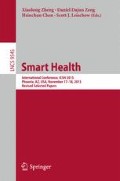Abstract
Recent researches on micro-blog based adolescent stress level prediction prove the feasibility of forecasting a teen’s future stress level through the stress time series detected from tweets. The previous work focuses on predicting the stress level or stress level change at the next time point, and doesn’t consider the problem of predicting the future stress trend in a period of time. In this paper, we employ a fuzzy candlestick line based model to address this problem on micro-blog, i.e., when a teen’s stress level comes to the top/bottom in the future. The candlestick line technique is a widely used stock trend analysis method in the financial domain. Experienced analysts usually use linguistic variables to describe the candlestick lines, such as long, short, and small. Thus we use the fuzzy set theory to represent the stress candlestick line in this paper. We define the stress patterns as a set of neighboring candlestick lines represented with fuzzy linguistic variables. Based on these fuzzy stress patterns, we make predictions using the fuzzy decision tree model. Experiments show the effectiveness of our prediction method.
Access this chapter
Tax calculation will be finalised at checkout
Purchases are for personal use only
References
APA’s 2013 Stress In America survey (2013). http://www.apa.org/news/press/releases/stress/2013/highlights.aspx
Bezdek, J.C.: Pattern Recognition With Fuzzy Objective Function Algorithms. Kluwer Academic Publishers, Norwell (1981)
Chen, S.: Forecasting enrollments based on fuzzy time series. Fuzzy Sets Syst. 81, 311–319 (1996)
Chen, S.: Forecasting enrollments based on high-order fuzzy time series. Cybern. Syst. Int. J. 33, 234–244 (2002)
Huang, K., Yu, T., Hsu, Y.: A multivariate heuristic model for fuzzy-time series forecasting. Syst. Manage. Cybern. 37, 836–846 (2007)
Lan, Q., Zhang, D., Xiong, L.: Reversal pattern discovery in financial time series based on fuzzy candlestick lines. Complex. Syst. Eng. Manage. 2, 182–190 (2011)
Lee, C.-H.L., Liu, A., Chen, W.-S.: Pattern discovery of fuzzy time series for financial prediction. IEEE Trans. Knowl. Data Eng. 18(5), 613–625 (2006)
Li, Q., Xue, Y., Jia, J., Feng, L.: Helping teenagers relieve psychological pressures: a micro-blog based system. In: EDBT (2014)
Li, Y., Feng, Z., Feng, L.: Using candlestick charts to predict adolescent stress trend on micro-blog. In: ICTH (2015)
Li, Y., Huang, J., Wang, H., Feng, L.: Predicting teenager’s future stress level from micro-blog. In: Proceedings of CBMS (2015)
Lin, H., Jia, J., Guo, Q., Xue, Y., Li, Q., Huang, J., Cai, L., Feng, L.: User-level psychological stress detection from social media using deep neural network. In: Proceedings of MM (2014)
Nison, S.: Japanese Candlestick Charting Techniques. Prentice Hall Press, Upper Saddle River (2001)
Park, M., McDonald, D., Cha, M.: Perception differences between the depressed and non-depressed users in twitter. In: Proceedings of ICWSM, pp. 476–485 (2013)
People’s Daily Online (2014). http://hm.people.com.cn/n/2014/0831/c230533-25574055.html
Song, Q., Chissom, B.S.: Forecasting enrollments with fuzzy time series - Part I. Fuzzy Sets Syst. 54, 1–9 (1993)
Song, Q., Chissom, B.S.: Forecasting enrollments with fuzzy time series - Part II. Fuzzy Sets Syst. 62, 1–8 (1994)
Teens, Social Media & Technology Overview 2015 (2015). http://www.pewinternet.org/2015/04/09/teens-social-media-technology-2015/
Umano, M., Okamoto, H., Hatono, I., Tamura, H., Kawachi, F., Umedzu, S., Kinoshita, J.: Fuzzy decision trees by fuzzy id3 algorithm and its application to diagnosis systems. In: Proceedings of the Third IEEE Conference on Fuzzy Systems, vol. 3, pp. 2113–2118, June 1994
Xue, Y., Li, Q., Jin, L., Feng, L., Clifton, D.A., Clifford, G.D.: Detecting adolescent psychological pressures from micro-blog. In: Zhang, Y., Yao, G., He, J., Wang, L., Smalheiser, N.R., Yin, X. (eds.) HIS 2014. LNCS, vol. 8423, pp. 83–94. Springer, Heidelberg (2014)
Acknowledgement
The work is supported by National Natural Science Foundation of China (61373022, 61073004), and Chinese Major State Basic Research Development 973 Program (2011CB302203-2).
Author information
Authors and Affiliations
Corresponding author
Editor information
Editors and Affiliations
Rights and permissions
Copyright information
© 2016 Springer International Publishing Switzerland
About this paper
Cite this paper
Li, Y., Feng, Z., Feng, L. (2016). When a Teen’s Stress Level Comes to the Top/Bottom: A Fuzzy Candlestick Line Based Approach on Micro-Blog. In: Zheng, X., Zeng, D., Chen, H., Leischow, S. (eds) Smart Health. ICSH 2015. Lecture Notes in Computer Science(), vol 9545. Springer, Cham. https://doi.org/10.1007/978-3-319-29175-8_23
Download citation
DOI: https://doi.org/10.1007/978-3-319-29175-8_23
Published:
Publisher Name: Springer, Cham
Print ISBN: 978-3-319-29174-1
Online ISBN: 978-3-319-29175-8
eBook Packages: Computer ScienceComputer Science (R0)

